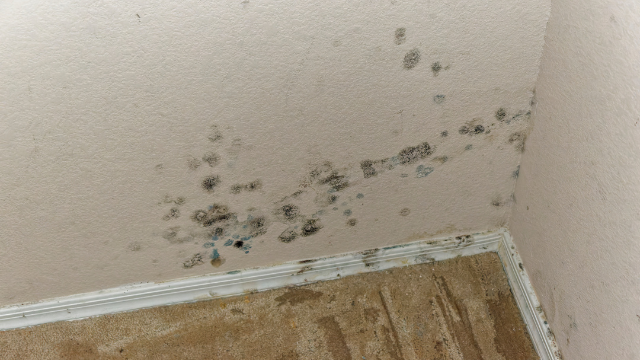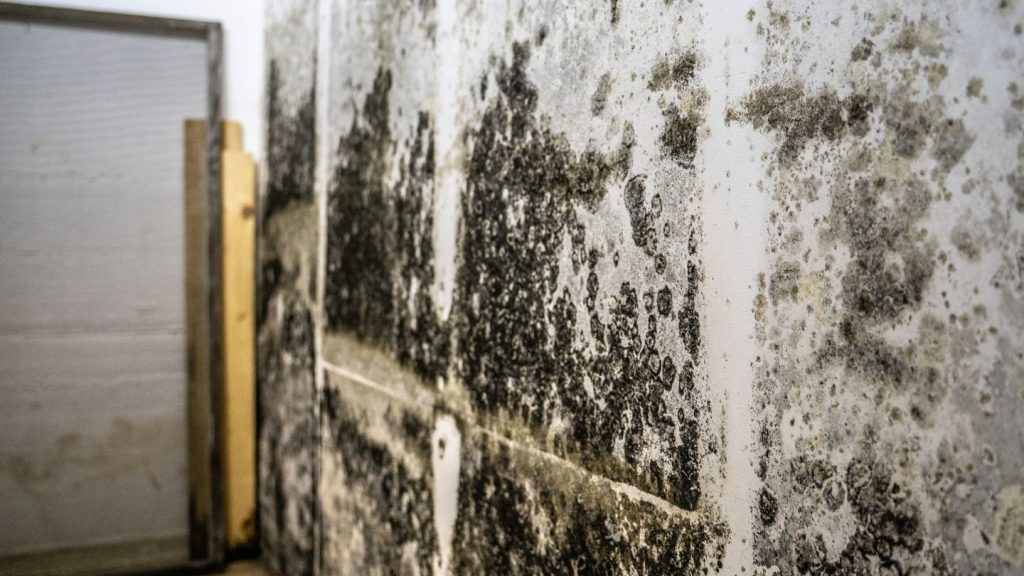As we strive to make our educational institutions safe and conducive to learning, there’s a silent threat that often goes unnoticed – mold. At United Water Restoration Group, we understand the dangers and concerns of widespread mold outbreaks, especially at an educational facility.
Mold should be addressed as quickly as possible to help prevent additional damage to the affected areas. United Water Restoration Group would like to go over the risks of black mold in schools and how mold remediation can help return the facility back to safety. Mold situations can be difficult to handle, especially widespread ones, however, professionals at United Water Restoration Group can assist!
Understanding Mold & How It Begins
Mold, a type of fungi, thrives in damp and humid environments, both indoors and outdoors. In schools, they can be found in classrooms, cafeterias, locker rooms, libraries, and anywhere that provides a hospitable environment. Mold reproduces through microscopic spores that are invisible to the naked eye and can easily become airborne, posing significant health risks to students and staff.

You may be wondering how mold grows and how quickly can it spread. Mold begins growing when spores land on damp or wet surfaces that contain organic material. This provides the mold with the moisture and nutrients it needs to grow. This can occur in areas with high humidity or water damage. The mold uses the organic material in drywall, wood, paper, carpet, or food as a source of nutrition, and under the right conditions, can start to grow within 24-48 hours.
Mold-Related Health Risks in Schools
The presence of mold in educational institutions is more than just a structural or cosmetic issue. It’s actually a major health concern. Here are some of the most common health problems associated with mold exposure:
Respiratory Issues: Exposure to mold can lead to a host of respiratory problems such as coughing, wheezing, and in severe cases, asthma attacks. Studies show that most household molds are linked to childhood asthma and other serious problems. Inhalation of mold should be avoided for prolonged periods of time.
Allergic Reactions: Mold spores can trigger allergic reactions which include sneezing, runny nose, red eyes, and skin rashes. For students and staff with a mold allergy, these symptoms can be severe as they are exposed for prolonged lengths of time.
Immune System Complications: Prolonged mold exposure can compromise the immune system, making students and staff more susceptible to infections. Breathing in mold spores can compromise your immune system due to the way these foreign particles can stimulate an immune response. In people with mold allergies or sensitivities, the inhalation of mold spores triggers the immune system to overreact, producing antibodies to combat these perceived invaders. This can result in allergic reactions. More seriously, in individuals with respiratory conditions such as asthma, mold spores can provoke inflammation in the airways, potentially triggering an asthma attack. Over time, the constant need to fight against mold spores can put a strain on the immune system, weakening it and potentially making it more difficult for the body to fend off other illnesses or infections.
Neurological Problems: Some research indicates that long-term exposure to certain types of mold can cause neurological problems such as memory loss and confusion. Prolonged exposure without protection can cause serious health concerns and should be avoided.
Mental Health Concerns: Emerging research suggests a potential link between indoor mold exposure and mental health issues such as depression and anxiety. The fear and stress associated with living or working in a mold-infested environment can further exacerbate mental health issues. There’s also the financial and emotional stress that comes with dealing with a mold infestation, which can be substantial.
Given these health risks, it is clear that tackling mold in schools should be a priority.
Detecting Mold in Educational Institutions
Detecting mold can be tricky, especially since it often grows in hidden areas. However, signs to watch out for include:
Visible Mold Growth: This is the most obvious sign of a mold issue. Mold may appear as a fuzzy or slimy patch of black, white, green, or yellow substance.
Musty or Damp Odors: Mold produces a characteristic musty odor that can be the first indication of a problem.
Health Symptoms: If students or staff members are experiencing allergic reactions or respiratory issues without an apparent cause, it could indicate the presence of mold.
Water Damage: Signs of water damage, such as discoloration or water stains, can be a precursor to mold growth.
High Humidity: High indoor humidity levels (above 60%) can encourage mold growth.
Implementing Mold Prevention Strategies in Schools
Preventing mold growth is key to maintaining a safe and healthy learning environment. Here are some practical strategies:
Manage Humidity Levels: Maintain indoor humidity below 60%, ideally between 30% and 50%, using air conditioners or dehumidifiers. The implementation of regular maintenance and inspection practices is key to a safe and healthy school environment. These practices should involve periodic checks for any signs of mold or moisture, particularly in areas prone to dampness such as bathrooms, basements, and kitchens. Furthermore, areas around water sources such as sinks, pipes, and water fountains should also be rigorously checked. Keeping these spaces clean and dry not only helps in reducing the likelihood of mold growth but also mitigates other issues linked to dampness such as pest infestations. The use of dehumidifiers and efficient ventilation systems can contribute to maintaining dry conditions. Promoting a culture of cleanliness among students and staff can further aid in this endeavor. Thus, these preventative measures collectively enhance the school’s overall health standards and ensure a conducive learning environment.
Ensure Proper Ventilation: All school buildings, particularly bathrooms, kitchens, and classrooms, should have adequate ventilation to reduce moisture levels. Proper ventilation is a fundamental aspect of maintaining healthy school environments. All school buildings, including bathrooms, kitchens, and classrooms, should be equipped with adequate ventilation systems to ensure a steady flow of fresh air. This can significantly aid in reducing moisture levels, consequently limiting the potential for mold growth and other moisture-related issues. Bathrooms and kitchens, areas often characterized by high humidity, particularly require efficient exhaust systems. For classrooms, where students spend a significant portion of their time, maintaining optimal indoor air quality is critical. This can be achieved through a combination of natural ventilation – opening windows and doors when weather permits – and mechanical ventilation systems. Regular inspection and maintenance of these systems are equally important to ensure they remain functional and effective. By fostering such practices, schools can contribute to a healthier, more conducive learning environment.
Regular Maintenance and Inspection: Conduct routine inspections for signs of mold or moisture and keep all school areas, especially the ones prone to dampness, clean and dry. The implementation of regular maintenance and inspection practices is key to a safe and healthy school environment. These practices should involve periodic checks for any signs of mold or moisture, particularly in areas prone to dampness such as bathrooms, basements, and kitchens. Furthermore, areas around water sources such as sinks, pipes, and water fountains should also be rigorously checked. Keeping these spaces clean and dry not only helps in reducing the likelihood of mold growth but also mitigates other issues linked to dampness such as pest infestations. The use of dehumidifiers and efficient ventilation systems can contribute to maintaining dry conditions. Promoting a culture of cleanliness among students and staff can further aid in this endeavor. Thus, these preventative measures collectively enhance the school’s overall health standards and ensure a conducive learning environment.
Quickly Address Water Leaks: Any signs of water leaks or damage should be promptly repaired, as mold can grow on wet surfaces within 24-48 hours. Effectively addressing water leaks is an essential aspect of property maintenance and health safety. When indications of water leaks or damage are detected, immediate action is imperative to prevent the escalation of issues. Damp areas provide an ideal environment for mold to thrive, typically starting to grow on wet surfaces within a short span of 24 to 48 hours. Mold spores can adversely affect the air quality, creating potential health risks for occupants. They are capable of causing allergic reactions, respiratory issues, and in extreme cases, more severe health complications. Hence, swift repair and thorough drying of the affected area are crucial steps in mitigating these risks. Additionally, regular inspections can help identify potential problem areas and address them before they escalate, making preventive measures a vital part of the solution.
Educate Staff and Students: Increase awareness about the health risks associated with mold and encourage everyone to report any signs of mold or water damage.
Addressing a Mold Problem
If you find mold in your school, it’s important to address it immediately. Here’s what to do:
Identify and Control the Moisture Source: Identify the source of moisture that’s facilitating mold growth and fix it to prevent further mold development.
Professional Mold Remediation: Hire a professional mold remediation service to clean up the mold safely and effectively.
Replace Mold-Infested Materials: Some materials like carpeting or ceiling tiles may need to be replaced if they’re heavily infested.
Implement Mold Prevention Measures: Once the mold is removed, implement the necessary prevention measures to keep the school mold-free.
The Role of School Administrators and Teachers
School administrators and teachers play a crucial role in recognizing, addressing, and preventing mold problems. They are the first line of defense in ensuring a safe and healthy environment. They can do so by raising awareness about the health risks of mold, regularly inspecting school facilities, promptly reporting water leaks or mold signs, and advocating for necessary resources to manage humidity and ventilation.
In conclusion, mold in educational institutions is a significant issue that deserves our attention. By understanding the associated health risks, being vigilant about detection, and actively implementing prevention strategies, we can ensure our schools remain safe and conducive to learning. Always remember – a healthy school promotes a healthy mind and body.
If you have spotted mold growth around your school, please contact professionals for assistance. Mold can create a dangerous situation for many and inhalation should be avoided. If you need assistance, contact United Water Restoration Group at (800) 430-5838 for help. Our service line is open 24 hours a day, 7 days a week, 365 days a year. Don’t delay and get help today, we can provide you with a free assessment and begin the process!





